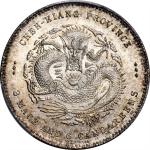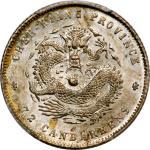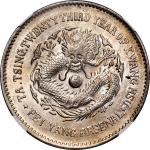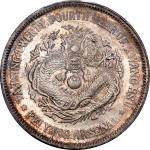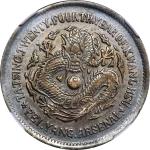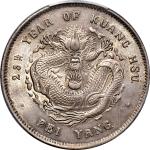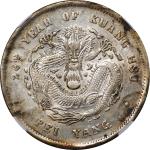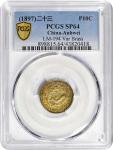USD 30000 - 50000
2022-05-04 13:00:00
2022-05-04 19:00:00
光绪二十三年安徽省造光绪元宝七分二釐铜样币。 亮丽夺目,罕见至极。熠熠生辉的近顶尖品相。光泽四溢,包浆动人,深红、鈷蓝及紫罗兰色交织。PCGS 评鉴中仅此一枚异质币,说是位属顶级大清省造或样币集藏亦毫不為过。
CHINA. Anhwei. Brass 7.2 Candareens (10 Cents) Pattern, Year 23 (1897). Anking Mint. Kuang-hsu (Guangxu). PCGS SPECIMEN-64. cf. L&M-194 (silver); cf. K-51 (same); cf. KM-Y-42 (same); cf. WS-1074 (same). Exceptionally brilliant and EXTRAORDINARILY RARE , this shimmering, glistening near-Gem presents a great deal of vibrant luster and tantalizing color that offers a melange of crimson, cobalt, and violet. Being the only example of the off-metal striking seen at PCGS, it is not a stretch to say that this minor is bound for a first-rate cabinet dedicated to provincial or pattern issues from imperial China.</p><em>
The Anhwei Mint, formerly located in the city of Anking, was originally founded in the 23rd year of Kuang Hsu (1897). Initially this mint was established for the purpose of producing local silver coinage with the intent to replace the then-popular Carolus 8 Reales; clearly, this goal was not achieved as 8 Reales remained in circulation well into the 20th century. While Edward Kann was conducting research for his masterpiece, Illustrated Catalog of Chinese Coins, he was unable to locate mint records for the Anhwei Mint. Today, the silver coinage from this province generally remains scarce to rare, suggesting rather small mintages. This short-lived mint produced coinage for approximately two years before coining operations ceased and the mint was dismantled. Perhaps the reason for the short-lived nature of the mint was the lower purity metallic content of its silver emissions. Coinage from this province was not widely accepted by neighboring provinces as it was found to be lower purity silver than the products of other mints. This is perhaps the reason that silver issues from this mint are often found with many chopmarks. After the mint was dismantled, a new mint in Anhwei was established in the 28th year of Kuang Hsu (1902); however, its activities were limited to the production of copper coinage. With the exception of the patterns which were struck in Germany, production of all Anhwei silver coinage occurred at the first mint in Anking.</em> <em>
The 2012 discovery of production material shed new light on the creation of this coinage. The findings included patterns, dies, hubs and a series of punches from the archives of the Otto Beh Company of Esslingen, Germany, specialists in the production of seals and dies. Before this, the origins of the dies used to produce coinage for the provinces of Anhwei (such as the present piece), Chekiang, Fengtien, Heilungkiang and Sungarei were only speculated upon. To date, patterns are known struck in silver, silvered-brass, brass and aluminum, but this does not include samples of everything that Beh produced, as the number and variety of dies far outnumber the known patterns. From neighboring Goppingen, Louis Schuler received an order for coining presses in 1895 and commissioned Otto Beh to manufacture the dies. In 1897 and 1898, Beh supplied Schuler with over 200 dies for Chinese coins. At the time, this was the largest order that the company had ever received. Schuler, which started as a Locksmiths shop in 1839, had grown to become one of the worlds leaders in metal forming and in fact supplied the aforementioned mints with coining presses.</em> </p>


